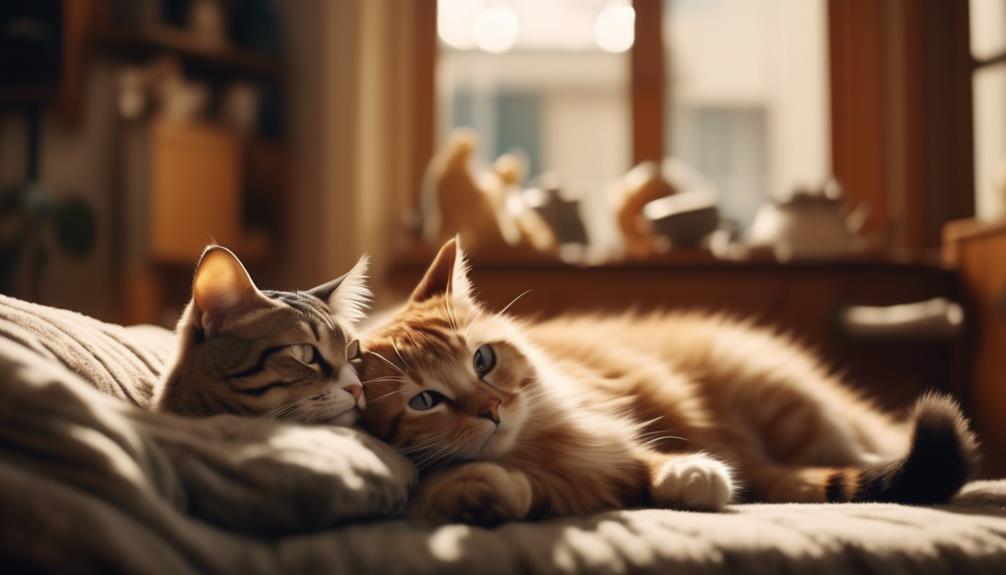The early domestication bonds between humans and cats have long fascinated researchers, shedding light on the intricate relationships between these two species.
As we explore the depths of this historical connection, it becomes evident that cats' domestication was a unique process, distinct from that of other domesticated animals.
The mutual benefits of coexistence between humans and cats have shaped not only the evolution of felines but also the course of human history.
Delving into the intriguing insights surrounding the early domestication of cats offers a glimpse into the profound impact these enigmatic creatures have had on human civilization.
Key Takeaways
- Cats share a common ancestor with wildcats, Felis silvestris.
- Cats have accompanied human settlements for over 9,000 years, indicating early stages of domestication.
- Ancient Egyptian artifacts provide evidence of the revered status of cats in ancient Egyptian society.
- Genetic analysis of cat remains in human burial sites supports the close human-cat bond in ancient civilizations.
Feline's Independent Evolution
The feline's independent evolution is characterized by a series of genetic and behavioral adaptations that have allowed these creatures to thrive in a variety of environments across the globe. Genetic evidence indicates that the domestic cat, Felis catus, shares a common ancestor with the wildcat, Felis silvestris. Over time, genetic mutations have occurred, leading to variations in coat color, pattern, and length, as well as changes in the ability to digest certain foods, such as lactose.
Behavioral adaptations have also played a crucial role in the independent evolution of felines. Solitary hunting behavior, territoriality, and communication through vocalizations and body language are key features that have allowed cats to survive and thrive. These behavioral adaptations have enabled them to efficiently hunt small prey, establish and defend territories, and communicate with conspecifics.
Understanding the genetic and behavioral adaptations of felines provides valuable insights into their evolutionary history and their ability to adapt to diverse environments. By recognizing and appreciating these traits, individuals can better serve the needs of domestic cats and contribute to their well-being.
Mutual Benefits of Coexistence
The evolutionary adaptations of felines have not only enabled their independent survival but also established a foundation for the mutual benefits of coexistence with humans.
Cats' evolutionary advantages, such as their exceptional hunting skills and solitary nature, have allowed them to thrive alongside humans.
Behavioral adaptations, including their ability to form social bonds and communicate with humans through vocalizations and body language, have contributed to their role as companions.
This coexistence has provided humans with pest control, as cats help manage populations of rodents and other pests. In return, humans have provided cats with food, shelter, and veterinary care.
The presence of cats has also been linked to reduced stress and anxiety in humans, highlighting the reciprocal nature of the relationship.
Furthermore, the bond between cats and humans has led to the domestication of cats, providing them with a stable environment and a consistent food source.
This mutualistic relationship has evolved over thousands of years, demonstrating the deep interconnection between felines and humans.
Historical Evidence of Human-Cat Bond
Throughout history, evidence of the bond between humans and cats has been documented through various cultural, artistic, and archaeological sources, shedding light on the enduring relationship between these two species.
Archaeological evidence has played a crucial role in unveiling the historical interaction between humans and cats. Ancient Egyptian artifacts, such as murals, sculptures, and cat mummies, have provided substantial evidence of the revered status of cats in ancient Egyptian society. Additionally, genetic analysis of cat remains found in human burial sites has further reinforced the notion of a close human-cat bond in ancient civilizations.
The archaeological evidence of cats accompanying human settlements in the Fertile Crescent, dating back to over 9,000 years ago, points towards the early stages of domestication and the mutually beneficial relationship between humans and cats. Moreover, the presence of cats in maritime communities like Cyprus, as depicted in ancient pottery and writings, indicates their role in pest control aboard ships and their integration into human activities.
These archaeological findings highlight the intertwined history of humans and cats, providing valuable insights into the deep-rooted and enduring human-cat bond.
Frequently Asked Questions
What Are Some Common Misconceptions About Early Domestication Bonds Between Humans and Cats?
Misunderstood bonds between humans and cats are influenced by cultural beliefs. Ancient connections reveal a complex human-cat interaction, often misconstrued. Scientific scrutiny is essential to dispel misconceptions and understand the nuanced dynamics of early domestication bonds.
How Has the Feline's Independent Evolution Influenced Their Behavior and Relationship With Humans?
The feline's independent evolution, driven by genetics and natural selection, has shaped their behavior, leading to a unique relationship with humans. Understanding feline behavior in light of their genetic and evolutionary heritage is paramount for nurturing harmonious human-cat bonds.
Are There Any Modern Examples of Mutual Benefits of Coexistence Between Humans and Cats That Are Not Mentioned in the Article?
Modern examples of mutual benefits of coexistence between humans and cats include their role in pest control, emotional support for individuals with mental health issues, and their potential as therapy animals for elderly or disabled individuals.
What Are Some Lesser-Known Historical Pieces of Evidence of Human-Cat Bonds That Have Been Discovered?
Historical artifacts and ancient artwork provide evidence of human-cat bonding rituals dating back millennia. Genetic evidence further supports this, revealing the enduring relationship between humans and cats. These lesser-known pieces enrich our understanding of the deep historical connection.
Can You Provide Examples of How the Early Domestication of Cats Has Influenced Their Genetics and Physical Characteristics?
Genetic adaptations in early domesticated cats led to physical traits suitable for cohabitation, influencing behavior and relationship dynamics with humans. These adaptations include reduced aggression, increased sociability, and a diverse range of coat colors and patterns.


